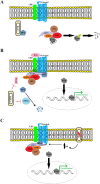The relationship between cancer risk and cystic fibrosis: the role of CFTR in cell growth and cancer development
- PMID: 40438286
- PMCID: PMC12107394
- DOI: 10.1039/d5md00203f
The relationship between cancer risk and cystic fibrosis: the role of CFTR in cell growth and cancer development
Abstract
Cystic fibrosis (CF) is a life-limiting genetic disease that affects multiple organ systems. It is caused by a mutation of the cystic fibrosis transmembrane conductance regulator (CFTR) gene, which results in the absence or damage of a relevant protein. If left untreated, it causes death in early childhood. The advent of more efficacious treatments has resulted in a notable increase in the life expectancy of CF patients. This has, in turn, led to an elevated risk of developing specific types of cancer. This review commences with an examination of CF from the standpoint of its etiology and therapeutic modalities. Subsequently, it presents a list of epidemiological studies that suggest an altered predisposition to certain cancers. A heightened risk is well documented, particularly in relation to the gastrointestinal tract. The following section addresses the role of CFTR in view of its potential involvement in the progression of various types of cancer. Several studies have indicated that the levels of the CFTR protein are reduced in many tumors and that this reduction is associated with the progression of the tumors. These decreased expressions are known to occur in the gastrointestinal tract, lungs, bladder, and/or prostate cancer. Conversely, ovarian, stomach, and cervical cancer are connected with its higher expression. The final section of the review focuses on the molecular mechanism of action of the CFTR protein in signaling pathways that affect cell proliferation and the process of carcinogenesis. This section attempts to explain the increased predisposition to cancer observed in patients with CF.
This journal is © The Royal Society of Chemistry.
Conflict of interest statement
The authors declare no conflict of interest.
Figures



Similar articles
-
[Chinese experts consensus statement: diagnosis and treatment of cystic fibrosis (2023)].Zhonghua Jie He He Hu Xi Za Zhi. 2023 Apr 12;46(4):352-372. doi: 10.3760/cma.j.cn112147-20221214-00971. Zhonghua Jie He He Hu Xi Za Zhi. 2023. PMID: 36990700 Chinese.
-
Cystic Fibrosis, CFTR, and Colorectal Cancer.Int J Mol Sci. 2020 Apr 21;21(8):2891. doi: 10.3390/ijms21082891. Int J Mol Sci. 2020. PMID: 32326161 Free PMC article. Review.
-
Targeting a genetic defect: cystic fibrosis transmembrane conductance regulator modulators in cystic fibrosis.Eur Respir Rev. 2013 Mar 1;22(127):58-65. doi: 10.1183/09059180.00008412. Eur Respir Rev. 2013. PMID: 23457166 Free PMC article. Review.
-
Correctors (specific therapies for class II CFTR mutations) for cystic fibrosis.Cochrane Database Syst Rev. 2018 Aug 2;8(8):CD010966. doi: 10.1002/14651858.CD010966.pub2. Cochrane Database Syst Rev. 2018. Update in: Cochrane Database Syst Rev. 2020 Dec 17;12:CD010966. doi: 10.1002/14651858.CD010966.pub3. PMID: 30070364 Free PMC article. Updated. Review.
-
Modulator-refractory cystic fibrosis: Defining the scope and challenges of an emerging at-risk population.Ther Adv Respir Dis. 2024 Jan-Dec;18:17534666241297877. doi: 10.1177/17534666241297877. Ther Adv Respir Dis. 2024. PMID: 39543951 Free PMC article. Review.
References
-
- Neglia J. P. FitzSimmons S. C. Maisonneuve P. Schöni M. H. Schöni-Affolter F. Corey M. Lowenfels A. B. C. F. and C. S. Group. N. Engl. J. Med. 1995;332:494–499. - PubMed
-
- Maisonneuve P. Marshall B. C. Knapp E. A. Lowenfels A. B. JNCI, J. Natl. Cancer Inst. 2013;105:122–129. - PubMed
-
- Bell S. C. De Boeck K. Amaral M. D. Pharmacol. Ther. 2015;145:19–34. - PubMed
-
- Andersen D. H. Am. J. Dis. Child. 1938;56(2):344–399.
-
- Andersen D. H. Hodges R. G. Am. J. Dis. Child. 1946;72(1):62–80. - PubMed
Publication types
LinkOut - more resources
Full Text Sources

